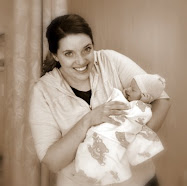Cutting your newborn's umbilical cord is a highly significant event and the job is considered a high honor in many places. There's a sense of pride in the words, "I cut the baby's cord." But far too many Americans who utter these words don't realize that there is an event far more significant than severing the cord, it’s the clamping of it.
Why is clamping significant? Because, in the majority of medically managed births, the umbilical cord clamp violently separates a newborn infant from a portion of their vital blood supply, possibly causing damage to the brain, heart and or lungs of the child before it even takes its first breath. Many Western OBs routinely clamp the umbilical cord before the child has been fully birthed. "So what? They're doctors, they know what they're doing." According to the majority of the research they don't. Here are several reasons why you might want to tell your doctor to delay clamping the cord and some of the research available to back you up when you do.
"The placental blood normally belongs to the infant, and his/her failure to get this blood is equivalent to submitting the newborn to a severe hemorrhage at birth." (from study 1, cited below)
When a human baby is born it needs to begin breathing air into its lungs in order to survive. However, it would be a mistake to imagine that a baby's first breath contains their body’s first experience of life-giving oxygen. Oxygen is provided for the fetus throughout the entire pregnancy by the mother, through the placenta. Following birth the placenta continues to provide oxygen for approximately 5 minutes while blood pumps, to and fro, through the umbilical cord. This is part of an ingenious plan of God’s (or nature’s) to allow the newborn time to "unfold" his/her lungs and to gently make the switch from living underwater to breathing air through the lungs. Remember, the infant is not receiving "placental" blood or even the mother's blood through the umbilical cord. The baby is retrieving its own blood supply from one of its own functioning organs that just happens to be inside its mother's body.
When the transfer of blood is given time to complete itself, the placenta and umbilical cord shut down, essentially dying. The blood vessels in the baby's cord close, the placenta separates from the uterine wall and is soon expelled, its function completed. With a simple cord tie and sterile cutting tools, the umbilical cord can be safely severed at this point. The baby is typically breathing well, pinked up and perhaps even nursing away contentedly in a reasonably calm mood. Of course, baby’s first surgical procedure doesn’t really need to be done immediately following birth or, even, at all. In times past when infections were more common and sterile tools were less common, our ancestors would frequently wrap the placenta in a diaper and swaddle it in with the baby until the cord dried out and the placenta fell off by itself, a few days after the birth.
But that’s probably not what happened to your baby, if s/he was born at a typical Westernized hospital. Most OBs and even CNMs are trained to clamp the cord during or immediately following birth. If you suggest the idea of waiting until the cord has stopped pulsing you will probably be confronted with at least one of two prevailing medical attitudes:
#1 ~ It's far too dangerous for me to allow the cord to pulse. You would be putting your baby at risk of : (pick one or more of the following choices) jaundice, plethora, hyperviscosity, or polycythemia.
and/or
#2 ~ What is all this touchy-feely stuff about the umbilical cord? Early clamping does no harm.
Let's look at the research and see if either of these statements hold water, shall we?
In 1993, a study by "Kinmond et al...found no increased jaundice, plethora, hyperviscosity, or polycythemia using this method. Yet fear of late clamping persists because physicians have been conditioned to believe that these complications are caused by placental over-transfusion. Cord stripping (allowing the baby to retrieve its own blood supply) has become tantamount to malpractice."
I found the above quote in an article (cited below, note 2) but haven't yet tracked down the Kinmond study itself. It truly makes sense to me though, nature's plan to ensure our survival of birth would not, by and of itself, cause such dire consequences. I would need to see an extremely convincing study proving that such things were happening to otherwise healthy infants of healthy mothers before I would believe it.
Mothering Magazine has this to say about jaundice. "Among other drugs, Pitocin inductions and epidurals have been conclusively linked with nonphysiological neonatal jaundice (this is not normal, breastfed jaundice). Any drug administered to mother or baby must be viewed with a 'jaundiced' eye, for it is likely to compete with bilirubin sites on blood protein, causing more bilirubin to be free to contribute to jaundice.
"In an all-out effort to prevent the possibility of jaundice, obstetric practitioners have reasoned against delayed cord clamping, since it increases the volume of red blood cells , which, in breaking down, will produce increased levels of bilirubin. True, hyperbilirubinemia may be prevented in premature and "medicated" infants by early clamping; however, in a normal delivery of a full-term, unmedicated infant, there are untold advantages to delaying cord clamping until after the placenta has delivered itself." (emphasis mine)
In fact, it seems that the practice of early cord clamping began during the days of heavily medicated births. Doctors deliberately stopped the blood flow to keep the newborns from retaining too much of the anesthesia their mothers were under. It's enough to make me think that being able to dole out drugs to laboring women is more important to doctors than preventing the various problems related to early cord clamping in newborn babies. A rather scary modern sign of the times, I fear.
When I published the first draft of this article, I got a comment from a mama who was told her doctor needed to clamp the cord early because she was diabetic and her baby was at risk of developing polycythemia (a thick blood disease) if the cord was not clamped early enough. I poked around and decided this was another obstetric myth. There are babies who do develop polycythemia and some of them are born to diabetic mothers. Late cord clamping does not appear to be a deciding factor for transmission of this condition.
On to argument #2, cord preservation is “touchy-feely, pseudo-science.” Early cord clamping has been shown to cause: newborn anemia, respiratory distress leading to brain damage and/or death (rare, yes, but it happens), inadequate blood supply resulting in a need for transfusion, possible heart defects resulting from problems closing off the hole in the heart valves following birth. There are a few doctors now theorizing that the rise in autism is due to brain damage caused by early cord clamping. The mother may suffer an increase in the length of the 3rd stage as well as increasing her blood loss following birth when her baby’s umbilical cord is clamped early.
More medical studies are needed with large control groups of babies who are not separated from their blood flow prematurely, but there is already ample evidence that early clamping is a violent, uncontrolled experiment that’s failing families.
Some more medical quotes:
"Deprivation of placental blood results in a relatively large loss of iron to the infant." (1)"The time of cord clamping may be involved in the pathogenesis of idiopathic respiratory distress syndrome (the earlier clamped, the more respiratory distress)." (3)
"Placental blood acts as a source of nourishment that protects infants against the breakdown of body protein." (1)
"Studies have shown that immediate cord clamping prolongs the average duration of the third stage and greatly increases maternal blood loss." (4)
"In order to give the newborn the blood that it need(s), physiologically cord clamping should be performed not immediately after birth. One should wait ... until the umbilical vein has been empty and is collapsed." (5)
"Normal blood volume is not produced by a cord clamp ... Many neonatal morbidities such as the hyperviscosity syndrome, infant respiratory distress syndrome, anemia, and hypovolemia correlate with early clamping. To avoid injury in all deliveries, especially those of neonates at risk, the cord should not be clamped until placental transfusion is complete." (2)
Early cord clamping may also be at least partly responsible for many of the cases of blood sensitization in Rh factor negative mothers, considering the blood is clamped off with enough force to create a brief “backflow” of the infant’s blood into the mother’s placental “wound.” Dr. Robert S Mendelsohn, M.D., in his book "How to Raise a Healthy Child. . . In Spite of Your Doctor" blames the entire Rh negative issue on early clamping of the cord. (This book is high on my recommended reading list for anyone with kids)
Recently, it has become widely known that umbilical cord blood is rich in stem cells and that they can be harvested and used to restore bone marrow in deficient children. It’s a lot cheaper and easier to just slow down birth and allow the child to absorb those rich, healthy stem cells while they’re fresh and available, immediately after birth. Any healthy mother and child should be encouraged to remain attached to each other for as long as it is comfortable, following a low risk birth.
Of course, there are some cases where the newborn is severely compromised at birth. In most of these cases, the cord is instantly severed so the birth attendants can whisk the baby off to the warmer. These are the very babies who need their blood the most! The premature, the distressed and those babies born by Cesarean sections may suffer needless interventions due to the practice of early cord clamping. Make sure that your birth attendant is made aware that you do not authorize early cord clamping long before you give birth. It isn’t time to argue the point once you are already in labor.
If your attendant does not indicate willingness to wait for the cord to stop pulsing, especially in an emergency, it may be time to consider firing them and having your baby in a safer environment. The first rule of medicine is supposed to be, "Do no harm." I, and many others, including many doctors and midwives of every stripe, believe that routine early cord clamping violates that oath. If your birth attendant doesn’t recognize this, find one who does. Delaying cord clamping is not nonsense. It is the very serious matter of your baby's health and well being.
1) De Marsh, QB, et al "The Effect of Depriving the Infant of its Placental Blood", JOUR AMA ? 7 June 1941
2) George M. Morley, MB., CH. B "Cord Closure: Can Hasty Clamping Injure the Newborn?", OBG Management - July 1998
3) Saigat, Saroj, et al. "Placental Transfusion and Hyperbilirubinemia in the Premature" PEDS 49:3 – March 1972
4) Walsh, S. Zoe "Maternal Effects of Early and Late Clamping of the Umbilical Cord" LANCET – 11 May 1968
5) Z Geburtshilfe "Cord clamping at birth - considerations for choosing the right time" Perinatol 1982 Apr-May;186(2):59-64


